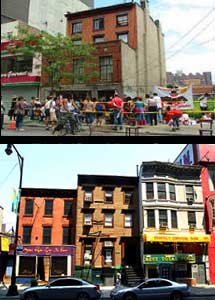“The time has come to revisit [the plan] in order to amend the zoning resolution to include such [affordable housing] provisions, and to fix what was started three years ago,” Markowitz said in a statement as part of an otherwise unrelated rezoning issue in Fort Greene and Clinton Hill.
The Downtown Brooklyn Partnership, a strong advocate for destroying the Abolitionist homes on Duffield, contends that 3,000 of the planned 17,000 new units in the pipeline will be affordable housing, but the Partnership declined to give details at this point.
Norman Oder explains:
That's because, out of nearly 3200 affordable units listed in a document distributed by the Partnership in April, 2250 of them are attributed to the Atlantic Yards project, which might extend the definition of Downtown Brooklyn, but was not included in the rezoning.
Many New Yorkers get confused the Atlantic Yards proposal and the Downtown Brooklyn rezoning confused. But the Downtown Brooklyn Partnership certainly knows the difference. So it's curious that they are trying to latch on to the benefits of the Atlantic Yards proposal.
Norman Oder has addresses similar issues in The unexpected housing boom in Downtown Brooklyn, some curious statistics, and an Errol Louis misreading:
deMause also points to "the incestuous nature of the planning process," involving public-private organizations led by staffers who worked for Deputy Mayor Dan Doctoroff or Borough president Marty Markowitz.
All of this raises an important question: What are the public benefits of the Downtown Brooklyn plan? If the plan is not living up to its promises, should the Economic Development Corporation continue with its eminent domain condemnation of private property? Eminent domain is only supposed to be used for some public good.
